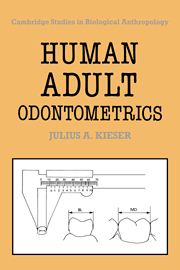Book contents
- Frontmatter
- Contents
- Foreword
- Preface
- 1 Introduction
- 2 Measurement of tooth size
- 3 Inheritance of tooth size
- 4 Comparative odontometry
- 5 Odontometric trends
- 6 Sexual dimorphism in tooth size
- 7 Odontometric variability
- 8 Compensatory tooth size interactions
- 9 Fluctuating odontometric asymmetry
- 10 Allometric relations of tooth size
- Odontometric appendix
- References
- Index
5 - Odontometric trends
Published online by Cambridge University Press: 05 February 2012
- Frontmatter
- Contents
- Foreword
- Preface
- 1 Introduction
- 2 Measurement of tooth size
- 3 Inheritance of tooth size
- 4 Comparative odontometry
- 5 Odontometric trends
- 6 Sexual dimorphism in tooth size
- 7 Odontometric variability
- 8 Compensatory tooth size interactions
- 9 Fluctuating odontometric asymmetry
- 10 Allometric relations of tooth size
- Odontometric appendix
- References
- Index
Summary
Introduction
The study of human odontometric trends relies upon repeated measurements of tooth size in a given population. Whilst short term trends may be evidenced by measurements taken on samples a human generation apart, the identification of long term trends will involve samples separated by thousands, or even millions of years.
Repeated dental measurements may show the tooth size of a population to be either static or varied. For teeth to remain the same size over a long period of time, two explanations may be proposed. One is that tooth size cannot readily be changed by selection because of restrictions imposed during ontogeny (developmental constraints), and the other is that individuals who have larger or smaller teeth are of lower fitness (stabilising selection). Tooth size variation over a long period of time may also be explained in terms of natural selection.
Given that natural selection will tend to preserve the most favourable variants within a population, it could be concluded that a change in the environment will pressurise a population towards the achievement of greater adaptation. Hence, if a change in tooth size enables a population to improve its ability to meet the challenge of a new environment, this change will be favoured by selection, and one may speak of a phyletic or evolutionary change in tooth size.
Slow but persistent alteration over a shorter period of time is referred to as a secular change. In human biological terms, the secular trend relates to those systematic short-term changes that occur in successive generations of adults, adolescents, children and neonates in a continuing population.
- Type
- Chapter
- Information
- Human Adult OdontometricsThe Study of Variation in Adult Tooth Size, pp. 50 - 62Publisher: Cambridge University PressPrint publication year: 1990



